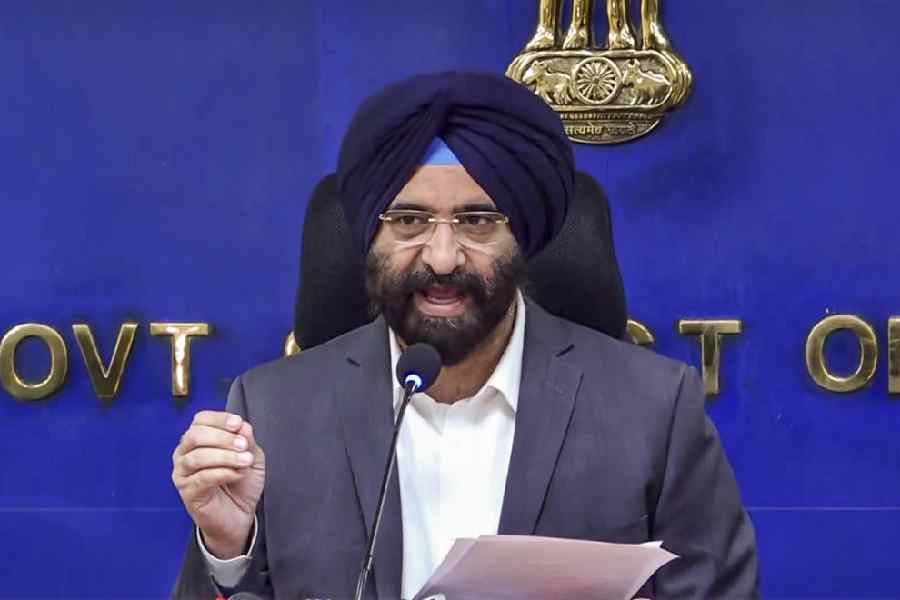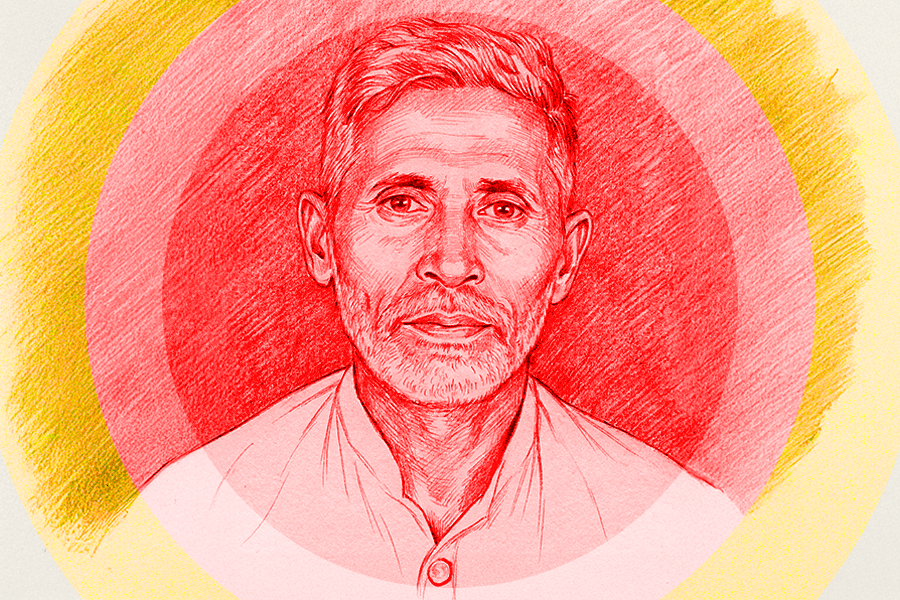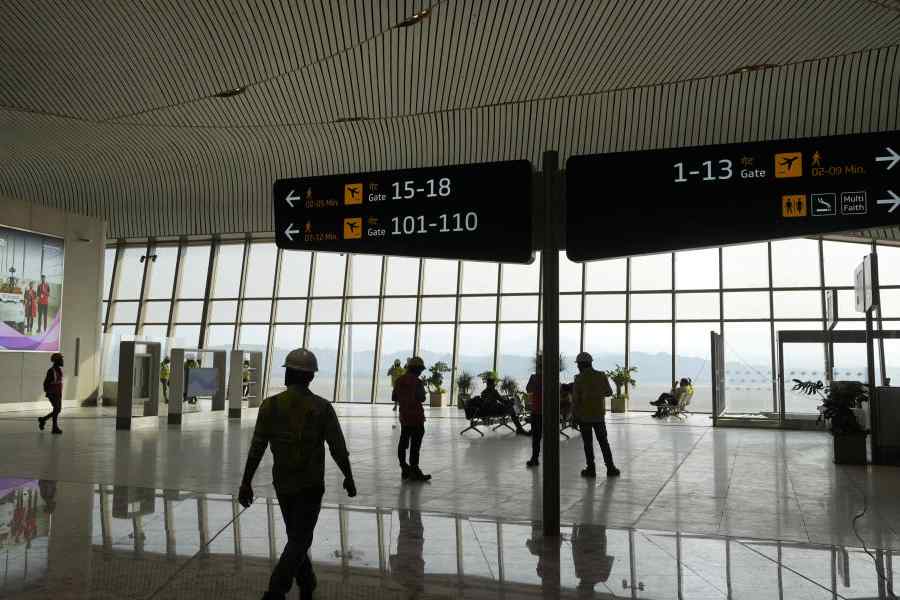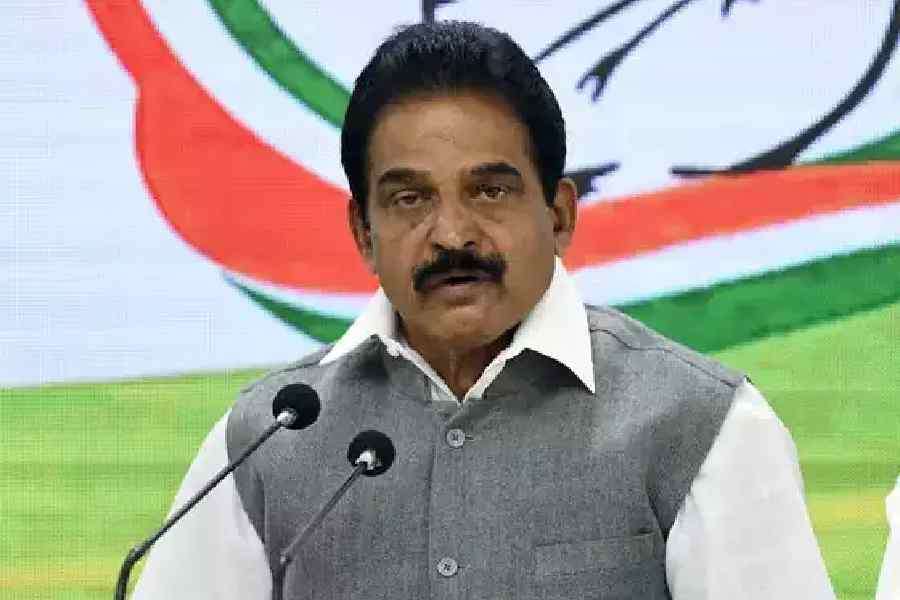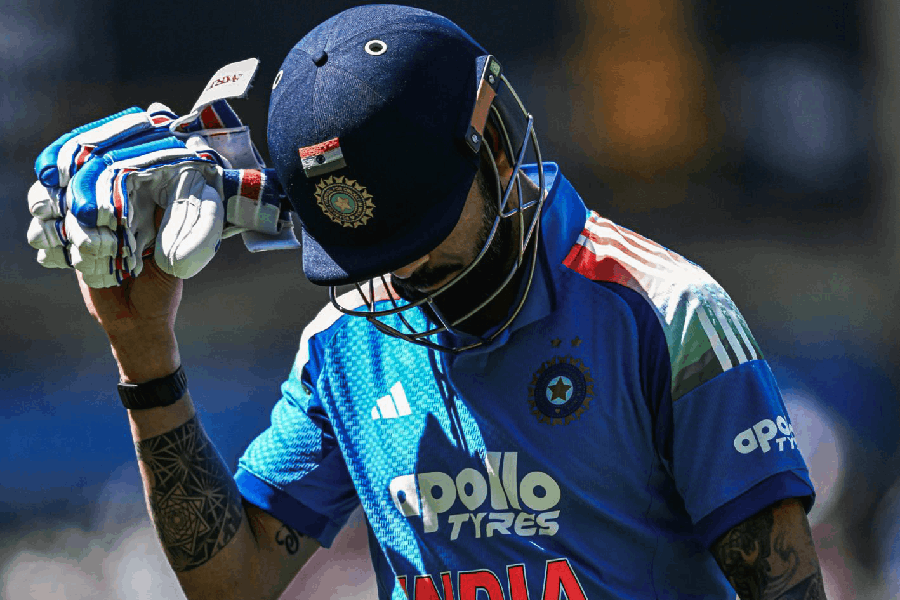 |
| Chhina with grandfather Arjan Singh’s tunic and medal. (Prem Singh) |
The waters of the Tigris were overflowing the banks that night but the men of the 53rd Sikhs had a task to do in the morning: breach the Turkish defences on the flat plains of Sannaiyat in Mesopotamia, modern-day Iraq.
Colour-Havildar Arjan Singh Chhina in Alpha Company was in the second of three lines to advance. Bullets “whistled past like banshees”, machineguns opened up and shrapnel from 3.7-inch pounders tore into bodies.
Arjan — the Jat Sikh was chosen as Colour-Havildar to carry the flag (colours) of his regiment at parades for his height and build — dropped to the ground, crawled, got up, ran and dropped to the ground again as the advance on the Turkish lines took heavy casualties. The withering fire stopped the advance some 800 metres from the Turkish trenches. But small groups tried to run forward in short bursts.
Arjan saw a British officer in one of the groups felled by bullets. He was still alive when the Colour-Havildar hoisted him on his back “like a sack of flour” and then, holding a rifle in one hand, with the officer on the other shoulder, carried him to the rear.
“These are facts I have pieced from his sheet roll, regimental records and family history,” says Squadron Leader (retired) Rana Tej Pratap Singh Chhina, Arjan’s grandson.
Some 26 months after he was shipped from India in September 1914 to, first, Egypt, then Aden and then Mesopotamia — and seven months after the April 6-7, 1916, Battle of Sannaiyat — Arjan was awarded the India Distinguished Service Medal (IDSM) for gallantry in action. The Great War had been waging for two years across several fronts.
Rana Chhina’s exploration of his family history through his grandfather’s participation in the First World War led him to write a book on the IDSM. Today, as he prepares to move house to a quieter locality in east Delhi, he sifts through the family’s belongings in search of his grandfather’s sword. He cannot find it. But he does find the Colour-Havildar’s tunic and medal.
Arjan was from Harsha Chhina, a village on the western edge of India near Amritsar’s Raja Sansi airport from where the Chhinas hail. In the village, as in the Punjab countryside, they still call WWI “Laam ki Ladai” (The Long War).
Indian Air Force pilots flying practice sorties from the airport in the dark look for the lights of Harsha Chhina to navigate their way to the airstrip. From aircraft above the village you can see the row of saffron lights that illuminate the fence on the International Border with Pakistan, a country that did not exist at the time of the Great War. The village now has star hotels.
A 100 years later and more than six decades after the birth of Pakistan, Rana Chhina is still looking for his grandfather’s citation. He believes it was lost in the tumult of Partition. But he did find the Gazette of India Army Department Notification No.1388 of November 17, 1916, that conferred the IDSM on his grandfather.
Back then, the 53rd Sikhs to which Arjan belonged had several recruits from the village, men who were driven to the army to supplement their family incomes from farming, rather than by the idea of valour or of the “martial races” touted by the British after the rebellion of 1857.
Arjan was one of more than 11 lakh Indians who served His Majesty in the Great War, which continued till 1918. They were not all soldiers. Lascars from Bengal and the east served in the navy; labourers and nurses served in all the fronts of the war: Europe, Mesopotamia, East Africa, Gallipoli, Palestine, Egypt. Many of them were buried where they fell; several thousand were taken prisoner.
Fighting a war that was not theirs to claim, the story of the Indians in WWI is now beginning to find new authors. Authors who challenge the idea that Indians were too eager to serve the King Emperor or that they sailed to distant places so that their service would so endear them to the British that they would grant self-rule or Independence.
“Soldiers never have a choice in any case,” says Rana Chhina, who now runs the Centre for Armed Forces Historical Research at the United Service Institution (USI).
“It’s about how the political class uses the military. The problem with Indians in the First World War is that the entire narrative is so coloured by the nationalist freedom struggle construct. Our soldiers were denied honours by the British because they were Indians, and by the Indians because they fought for the British,” he says.
But oral history lives on and even today animates discussions in families like Rana Chhina’s. It is as if the shell shock that Arjan felt ripples through the generations. WWI was really the first great industrialised killing of people, with machines mowing down soldiers from the subcontinent who were new to the firepower of howitzers and machineguns.
Rana Chhina talks of how his grandfather was saved by his “Brandy”. “Brandy” was the name given to the greatcoats that the soldiers were issued. Since it kept them warm — like the liquor — the greatcoat was named after it.
Arjan was fighting his way up the Tigris with his battalion to relieve the British soldiers besieged at Kut Al Amara in Mesopotamia. During one march he was knocked out cold. A bullet fired from behind had entered his “Brandy”, which was rolled up and slung across his neck. The Brandy took the bullet. Arjan fell down, the air emptying from his lungs, but survived. He went on to fight other battles.
Rana Chhina recalls a story told by an aunt. His maternal grandfather — Nana — was also deployed in Mesopotamia with his regiment during the trench warfare before the siege of Kut Al Amara was lifted.
One day, Rana Chhina’s two grandfathers happened to meet in the trenches. It was also the day his maternal grandfather had received a letter informing him he now had a daughter in addition to three sons. As soldiers gathered round to hug him, one sepoy stood up, his head rising above a parapet. A bullet went through it.
“Indeed, if there was anything universal about the experience of the western front, it was that the encounter between human flesh and high explosive was always a one-sided affair,” writes Andrew Tait Jarboe in his dissertation “Soldiers of Empire: Indian sepoys in and beyond the imperial metropole during the First World War”.
hough Jarboe focused on the Indian soldiers in Europe, many of his observations hold true for the other fronts as well.
Indian soldiers were first sent to Europe where the British and French took heavy losses after the Germans invaded Belgium. In 1914-15, in the first year of the war, there were an estimated 138,000 Indians in Europe. That was the time of trench warfare — long days and nights of digging into the ground and taking shots at the enemy.
At the Indian Military Academy (IMA), Dehradun, through which all officers of the Indian Army pass, lessons learnt from trench warfare are still taught. A century after that dirty war, trench warfare is still configured into the realities of India’s and Pakistan’s armies.
A former officer recalls the history of trench warfare taught at the IMA: “In field craft, we were told that if birds are chirping on the enemy’s side, it means the trenches are being vacated.”
Indian soldiers first got into the trenches in October 1914, at Ypres, Givenchy, Festubert and Neuve Chapelle. Jarboe says there was a 475-mile network of trenches “snaking from the Belgian coast to the Swiss border”.
“Along the seven miles of trench held by the Indian Corps throughout 1915, one could find Muslims and Sikhs from the Punjab, Hindus from Rajasthan, Afghan Afridis from the Khyber Pass or Gurkhas from the foothills of Nepal. Indeed, a visit to the British sector of the western front at any given time might reveal not just Britons and Indian sepoys, but Anglo and First Nation Canadians, Newfoundlanders, Jamaicans, Australians, New Zealanders, Maoris, South Africans or Egyptians. Navigating the length of the western front might require competency beyond just English, French and German,” writes Jarboe.
Great Britain had put the might of her Empire into the war making its subjects “pawns in a murderous game”. The soldiers themselves, it is evident from their letters, wanted above all to return home safely.
Arjan was lucky to get away. He told his family how difficult it was. High-caste Hindus in the Indian soldiery worried that they had to eat horseflesh in the trenches. Arjan’s younger brother, Bugle-Major Harnam Singh, was also in the army and with the unit in Mesopotamia.
Their eldest brother, who looked after the family farm, died in mid-1917. Arjan requested he be sent home. He served in an army depot in Jalandhar till 1919 when he was discharged. He died of natural causes in 1939, the year the Second World War began.
MODERN-DAY ‘MAHABHARAT’
● In 1914, the army of India had 77,000 British and 16,000 Indian soldiers — the largest complement of Allied Forces. An Indian battalion had 764 men on an average
 |
| Medals won by Indian soldiers and a letter from King George V appreciating the services of the Rajputana Rifles in World War I (Prem Singh) |
● The cost of the war made India bankrupt but The Times, London, editorialised: “The Indian Empire has overwhelmed the British nation by the completeness and unanimity of its enthusiastic aid”
● A sepoy’s salary in 1917 (three years after World War I began) was Rs 11 per month
● Indian soldiers (including those from today’s Pakistan and Gorkhas from Nepal) won 12 Victoria Crosses for gallantry
● Indian troops were first deployed in the Battle of Ypres in Belgium in September 1914.
They later fought in all the other fronts: Mesopotamia, Gallipoli, North and East Africa, Palestine, Egypt, Singapore
DEAR HOME...
Excerpts from letters written by Indian soldiers from the Lahore and Meerut Divisions (source: Reports of the Censor of Indian Mails in France 1914-1918, 27 volumes, India Office Records, British Library). Most of these were in Indian languages, dictated by the soldiers to clerks and others
■ From Nariman (a Parsi), Hospital Ship “Latitia” to MB Marfatia, Lal Darwaja, Ahmedabad (Gujarati); April 12, 1915: “...Further, it is not at all likely, I think, that we shall be coming to India. Instead of going to India we shall go under to Hell (implied)... it is to be hoped that Uncle Censor will forward this letter on safely.”
■ Jats/From Mohan Lal/Kitchener Indian Hospital, Brighton, to Bhagmal Jat, Village Mungane, P.O. In India (Hindi, April 1915): “Having seen this war all that has been written in the Mahabharat and in the Ramayan is altogether true.... There is fighting on land, under the earth, in the sea, and in the air. To say nothing of the rifles and cannon, the fire of which can be heard twenty-four miles.”
■ An Indian soldier writing from Marseilles, France, Jan. 14 1915, narrating a story attributed to Caliph Hazrat Umar: The soldier asked a daughter how long can a woman do without a man. The daughter raised three fingers, meaning three months. The writer makes the case that soldiers should be given leave every three months.
■ Rajput/From Bhagwan Singh, France, to Naik Karpal Singh, Signaller, 96th Besar Infantry, Chateau Moreau, Marseilles. (Hindi, 1915): “Do all you can to avoid coming here.... I am very sorry about my brother and also extremely sorry that the 7th Rajputs have lost so many in the Persian Gulf.”
What the Great war gave us
KILLING MACHINES...
Rifles: Indian troops used mostly Lee Enfield Mark I and Lee Metford; also Short Lever Martini Henry
Pistols: Used by seniors in vehicles, and later by troops in tanks because of confined spaces
Poison gas: The Germans first used chlorine gas in the Second Battle of Ypres, 1915. Later used by the British too
Achinegun: Transformed warfare by killing scores in single bursts
Aircraft: The Germans used them first, for recce
Railways: The Germans, Turks and the Russians used them to move massive numbers of troops
Aircraft carriers/submarines: The first aircraft flew from the deck of HMS Hibernia in 1912, two years before the war. The Germans used submarines or U-boats first in the North Atlantic in 1914
Tanks: The idea that defeated trench warfare. The first was probably a British Mark I used in the Battle of the Somme, 1916
These developments took a heavy toll on Indian soldiers, used by the British since the 1857 revolt mostly in “small wars”. Since 1857, the British had armed Indian troops with weapons a generation behind the ones used by British troops
...AND SAVING GRACES
Motorised ambulance: Likely first appearance in Mesopotamia, 1916; WWI was the first war in which soldiers could be treated for wounds and sent back to the front
Sanitary napkins: First used by French nurses who made do with bandages. Industrial production began in the US immediately after the war ended
 |
 |
 |
 |
 |
 |
 |
| (From top) Flintlock rifle; 13-pounder British QF Gun, preserved at College of Materials Management, Jabalpur; Machinegun on tripod; Musket; Mannequins showcasing the Rashtriya Rifles’ ceremonial uniforms during WWI. (Prem Singh), Recoilless cannon; Japanese 4.2-inch howitzer, preserved at Ahmednagar Cantt |
| (For 1, 3, 4,and 6 These weapons were captured from Turkish forces by Indian soldiers in Mesopotamia during WWI. Pictures taken by Prem Singh at the museum of the Rajputana Rifles Regimental Centre in New Delhi) |
| (Courtesy retired Brig. S.K. Chatterjee, former artillery officer and author of Vintage Guns of India) |


